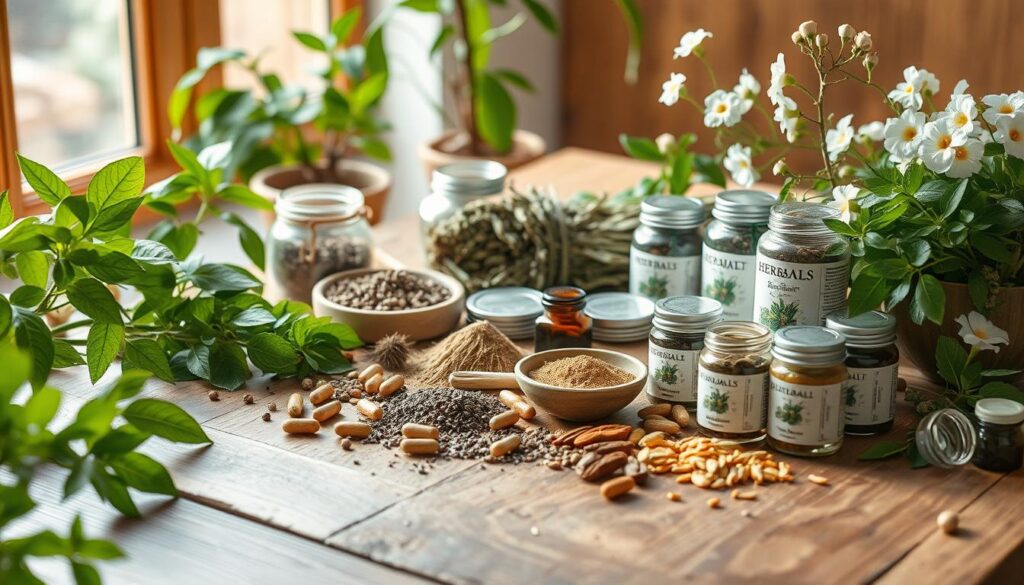In the face of the ongoing battle against Lyme disease and its debilitating aftermath, a holistic approach has emerged as a powerful and transformative path to healing. This article explores the comprehensive strategies that can help individuals reclaim their health and well-being, guiding them through the intricate journey of recovering from both Lyme disease and the often-persistent post-treatment syndrome.
Key Takeaways
- Understand the complexities of Lyme disease and its long-term impact on the body
- Discover the benefits of a holistic approach to healing, addressing the whole person
- Explore the role of nutrition, mind-body practices, and natural remedies in supporting recovery
- Learn how to create a supportive environment and integrate alternative therapies
- Develop strategies to monitor progress and maintain a healthy lifestyle in the long term
Understanding Lyme Disease and Its Impact
Lyme disease is a complex and multifaceted illness caused by the Borrelia burgdorferi bacteria, which is transmitted through the bite of an infected tick. This debilitating condition can have far-reaching consequences for those who contract it, leading to a range of challenging symptoms and long-term health issues.
What is Lyme Disease?
Lyme disease is a tick-borne illness that is becoming increasingly prevalent, particularly in regions with high tick populations. The disease is typically contracted through the bite of a blacklegged tick, also known as a deer tick, that is carrying the Borrelia burgdorferi bacteria. If left untreated, the infection can spread throughout the body and affect various organ systems.
The Symptoms and Challenges
- Early-stage Lyme disease often presents with a characteristic “bull’s-eye” rash, accompanied by flu-like symptoms such as fever, chills, and fatigue.
- As the infection progresses, patients may experience neurological complications, joint pain, muscle aches, and heart problems.
- The wide range of symptoms and the ability of the bacteria to hide from the immune system make Lyme disease a challenging condition to diagnose and treat effectively.
Post-Treatment Lyme Disease Syndrome
Even after receiving standard antibiotic treatment, some individuals may continue to experience persistent symptoms, a condition known as post-treatment Lyme disease syndrome (PTLDS). This can be a frustrating and debilitating experience, as the causes and optimal treatment for PTLDS are still being researched.
Understanding the complexity of Lyme disease and its potential long-term effects is crucial for those seeking effective Lyme disease treatment and post-treatment Lyme disease syndrome management.
Holistic Approach to Healing
When it comes to addressing Lyme disease and its aftermath, a holistic approach is essential. This integrative approach acknowledges the interconnectedness of the body, mind, and spirit, recognizing that true healing extends beyond just treating the physical symptoms.
What is Holistic Healing?
Holistic healing is a comprehensive philosophy that aims to restore balance and harmony within the entire person. It goes beyond conventional medical treatments, incorporating a wide range of modalities, from nutrition and exercise to mindfulness and herbal remedies. The goal is to support the body’s natural healing abilities by addressing the root causes of illness, not just the symptoms.
Importance of Treating the Whole Person
- Recognizes the complex, multifaceted nature of Lyme disease and its impact on overall well-being
- Addresses physical, emotional, and mental aspects of health for a more complete recovery
- Empowers individuals to take an active role in their healing journey through lifestyle changes and self-care practices
- Integrates conventional and alternative therapies to create a personalized, holistic approach tailored to individual needs
- Fosters a deeper understanding of the interconnectedness between the body, mind, and spirit, promoting integrative medicine approaches
By embracing a holistic approach to healing, individuals with Lyme disease and post-treatment syndrome can address the multifaceted challenges they face, ultimately leading to a more comprehensive and sustainable recovery.

“The greatest medicine of all is to teach people how not to need it.” – Hippocrates
Nutritional Support for Recovery
When it comes to healing from Lyme disease and post-treatment syndrome, proper nutrition plays a vital role. By embracing a holistic approach, individuals can harness the power of natural remedies and support their body’s innate ability to recover. Let’s explore the key elements of a nutritional plan that can aid in chronic illness recovery.
Foods to Embrace
A nutrient-dense diet focused on whole, unprocessed foods can provide the essential nourishment needed during the recovery process. Some of the most beneficial foods to incorporate include:
- Organic, non-GMO fruits and vegetables, rich in antioxidants and phytonutrients
- Lean proteins such as wild-caught fish, grass-fed meat, and plant-based options like legumes and quinoa
- Healthy fats from avocados, nuts, seeds, and olive oil
- Probiotic-rich foods like fermented veggies, kefir, and kombucha to support gut health
Supplements to Consider
In addition to a nutrient-dense diet, some individuals may benefit from incorporating targeted supplements to address specific needs during their Lyme disease recovery. Common supplements that may be helpful include:
- Omega-3 fatty acids to reduce inflammation
- Vitamin D and B-complex vitamins to boost immune function
- Probiotics to restore gut balance
- Antioxidants like glutathione and N-acetylcysteine to support detoxification
Creating a Balanced Diet
Developing a balanced, personalized nutrition plan is essential for supporting the body’s natural healing process. By working with a qualified healthcare provider or nutritionist, individuals can create a dietary approach that meets their unique needs and preferences, while also addressing any specific nutrient deficiencies or imbalances.
Remember, the journey to recovery is not one-size-fits-all, and the right nutritional support can make a significant difference in managing chronic illness and supporting overall well-being.
The Role of Mind-Body Connection
When it comes to recovering from Lyme disease and post-treatment syndrome, the mind-body connection plays a crucial role. The impact of stress on healing cannot be overstated, as our mental and emotional well-being directly influence our physical health. By embracing a holistic approach that addresses both the mind and the body, individuals can unlock the full potential of their recovery journey.
Impact of Stress on Healing
Chronic stress can have a detrimental effect on the body’s ability to heal and recover from Lyme disease. Elevated cortisol levels and inflammation can impede the body’s natural healing processes, leading to prolonged symptoms and a slower recovery. Recognizing the role of stress in Lyme disease is essential for developing an effective holistic treatment plan.
Techniques for Mindfulness
Incorporating mindfulness-based practices into one’s lifestyle can be immensely beneficial for individuals with Lyme disease. Techniques such as meditation, deep breathing, and guided imagery can help reduce stress, promote relaxation, and foster a deeper mind-body connection. By cultivating a greater sense of presence and self-awareness, individuals can learn to manage their symptoms more effectively and support their overall well-being.
| Mindfulness Technique | Benefits for Lyme Disease Recovery |
|---|---|
| Meditation | Reduces stress, improves focus, and promotes emotional regulation |
| Deep Breathing | Calms the nervous system, enhances oxygenation, and induces relaxation |
| Guided Imagery | Visualizes positive outcomes, reduces pain perception, and enhances the body’s natural healing abilities |

By harnessing the power of the mind-body connection and incorporating mindfulness-based techniques into their recovery plan, individuals with Lyme disease can unlock the full potential of their healing journey. This holistic approach empowers them to take an active role in their well-being and supports their journey towards optimal health and wellness.
Physical Activity and Rehabilitation
Embarking on a chronic illness recovery journey often requires a holistic approach, and physical activity plays a crucial role in the process. Gentle exercise can offer a myriad of benefits for individuals recovering from Lyme disease and Post-Treatment Lyme Disease Syndrome (PTLDS).
Benefits of Gentle Exercise
Engaging in appropriate physical activity can help improve strength, flexibility, and overall well-being. By gradually introducing gentle exercises, individuals can regain their physical capabilities without overwhelming their bodies. Gentle exercise can also aid in reducing fatigue, enhancing mood, and promoting better sleep – all essential components of the chronic illness recovery process.
Recommended Activities
When it comes to physical activity during Lyme disease recovery, it’s essential to start slow and listen to your body. Some recommended gentle exercises include:
- Yoga and stretching: Gentle, restorative yoga practices can help improve flexibility, balance, and mindfulness.
- Walking: Brisk walking in short, manageable durations can gradually increase endurance and cardiovascular health.
- Swimming or water-based activities: Low-impact exercises in the water can provide a therapeutic environment for rehabilitation.
- Tai Chi: This ancient Chinese practice combines gentle movements, breathing, and meditation, promoting both physical and mental well-being.
Remember, the key is to gradually increase the duration and intensity of physical activities, always staying within your comfort level and energy limits. By incorporating gentle exercise into your holistic approach to chronic illness recovery, you can take meaningful steps towards regaining your strength and vitality.
Herbal Remedies and Natural Treatments
As part of a holistic approach to healing from Lyme disease and post-treatment syndrome, herbal supplements and natural remedies can play a vital role. These plant-based solutions offer a gentle, yet effective way to support the body’s natural healing processes and alleviate various symptoms.
Popular Herbs for Lyme Disease
Several herbs have gained recognition for their potential benefits in managing Lyme disease and its associated challenges. Some of the most widely used herbal supplements include:
- Echinacea – Known for its immune-boosting properties, echinacea may help the body fight off Lyme-related infections.
- Cat’s Claw – This herb is believed to have anti-inflammatory and antioxidant effects, which can be beneficial for reducing inflammation and oxidative stress caused by Lyme disease.
- Astragalus – This adaptogenic herb is thought to enhance the body’s resistance to stress and support overall wellness during the recovery process.
- Olive Leaf Extract – Olive leaf has been studied for its potential antimicrobial and anti-inflammatory properties, which may aid in managing Lyme-related symptoms.
How to Use Herbal Remedies Safely
When incorporating herbal supplements into your Lyme disease treatment plan, it’s crucial to do so under the guidance of a qualified healthcare professional. Proper dosage, timing, and potential interactions with other medications must be carefully considered to ensure the safe and effective use of these natural remedies.

It’s also important to source your herbal supplements from reputable brands and to be mindful of any potential allergies or sensitivities. Starting with lower doses and gradually increasing as needed can help your body adjust to the new herbal supplements. With the right approach, these natural treatments can be a valuable complement to your overall holistic healing journey.
Building a Supportive Environment
Recovering from Lyme disease and post-treatment syndrome requires a holistic approach that involves not just physical healing, but also emotional and social support. Building a strong support system can be instrumental in the chronic illness recovery process.
Building Relationships for Healing
Surround yourself with people who understand the challenges you’re facing and are willing to offer compassion and encouragement. Lean on family members, close friends, and trusted healthcare providers who can provide a listening ear and practical assistance when needed. These relationships can help alleviate feelings of isolation and provide a sense of community during the recovery journey.
The Role of Support Groups
- Connect with others who have experienced Lyme disease or post-treatment syndrome. Support groups, both in-person and online, can be invaluable resources for sharing experiences, exchanging coping strategies, and finding camaraderie.
- Participate in group activities or discussions that focus on the holistic aspects of healing, such as nutrition, mindfulness, or alternative therapies.
- Seek out support groups that align with your personal beliefs and preferences, whether it’s a faith-based, community-driven, or specialized group.
By cultivating a supportive environment and embracing the power of connection, individuals with Lyme disease and post-treatment syndrome can enhance their overall well-being and increase their chances of achieving a successful, holistic recovery.

Integrating Alternative Therapies
As we explore the world of holistic healing for Lyme disease, alternative therapies emerge as powerful allies in the journey toward wellness. Two such modalities that hold significant promise are acupuncture and meditation, both of which can be seamlessly integrated into a comprehensive integrative medicine approach.
Acupuncture and Its Benefits
Acupuncture, a centuries-old practice rooted in traditional Chinese medicine, has gained increasing recognition for its ability to alleviate the symptoms associated with Lyme disease. By targeting specific meridian points on the body, acupuncture can help to:
- Reduce inflammation and pain
- Boost the immune system
- Improve circulation and promote healing
- Alleviate neurological symptoms like headaches and cognitive fog
Many individuals with Lyme disease have found acupuncture to be a valuable complement to their conventional treatment plan, reporting improved overall well-being and a greater sense of balance in their bodies.
Meditation for Healing
In addition to the physical benefits of alternative therapies, the mind-body connection plays a crucial role in the healing process. Meditation, a practice that encourages deep relaxation and mindfulness, has been shown to have a profound impact on individuals with Lyme disease and post-treatment syndrome. By:
- Reducing stress and anxiety
- Enhancing mood and emotional regulation
- Improving sleep quality
- Promoting a greater sense of inner peace and resilience
Incorporating meditation into one’s wellness routine can be a powerful tool in the arsenal of alternative therapies and integrative medicine approaches to Lyme disease management.

As the journey toward recovery from Lyme disease continues, embracing a holistic approach that combines conventional treatments with alternative therapies like acupuncture and meditation can offer a more comprehensive path to healing and wellness.
Sleep and Restorative Practices
Achieving quality sleep is a crucial component of a holistic approach to healing from Lyme disease and post-treatment syndrome. Restorative sleep not only allows the body to rest and repair but also supports the mind’s ability to process emotions, consolidate memories, and regulate immune function – all of which are essential for recovery.
Importance of Sleep in Recovery
During sleep, the body enters a rejuvenating state, allowing it to focus its resources on fighting infections, reducing inflammation, and restoring balance. Insufficient or poor-quality sleep can exacerbate symptoms, impair cognitive function, and hinder the healing process. By prioritizing sleep, individuals with Lyme disease can optimize their chances of a full recovery.
Tips for Improving Sleep Quality
- Establish a consistent sleep schedule, going to bed and waking up at the same time each day.
- Create a calming sleep environment with minimal light, noise, and distractions.
- Engage in relaxing activities before bed, such as gentle yoga, meditation, or reading a book.
- Limit the use of electronic devices, which can disrupt the body’s natural sleep-wake cycle.
- Consider natural remedies, such as herbal teas or essential oils, to promote relaxation and restful sleep.
- Avoid caffeine, alcohol, and heavy meals close to bedtime, as they can interfere with sleep quality.
By implementing these holistic sleep-enhancing strategies, individuals with Lyme disease can support their body’s natural healing processes and improve their overall well-being.

| Benefits of Quality Sleep | Consequences of Poor Sleep |
|---|---|
| Supports immune function | Weakens immune response |
| Reduces inflammation | Increases inflammation |
| Enhances cognitive abilities | Impairs mental clarity and focus |
| Promotes emotional balance | Exacerbates mood disturbances |
| Facilitates tissue repair and regeneration | Slows down the healing process |
By prioritizing sleep and incorporating natural remedies, individuals with Lyme disease can support their holistic healing journey and improve their overall quality of life.
Monitoring Progress and Adjusting Plans
Embarking on the journey to heal from Lyme disease or chronic illness requires unwavering commitment and vigilance. One of the keys to successful recovery is closely monitoring your progress and being willing to adjust your treatment plan as needed. By keeping a detailed health journal and seeking professional guidance when necessary, you can navigate the ups and downs of this process and steadily move towards better health.
Keeping a Health Journal
Maintaining a comprehensive health journal can be an invaluable tool in your Lyme disease treatment and chronic illness recovery efforts. Recording your symptoms, progress, and any changes in your condition can help you identify patterns, measure the effectiveness of your interventions, and make informed decisions about your care. Consider including the following in your journal:
- Daily symptom tracking, including severity and duration
- Detailed notes on your diet, supplements, and other therapies
- Observations on your sleep, energy levels, and mood
- Reflections on your overall well-being and any milestones achieved
When to Seek Professional Help
While holistic healing can be incredibly empowering, there may be times when seeking professional guidance is necessary. If you experience a significant worsening of your symptoms, or if you feel that your recovery has stalled despite your best efforts, it’s important to consult with your healthcare provider. They can help you identify any underlying issues, adjust your treatment plan, and provide the support you need to continue your journey towards better health.
Remember, the road to recovery is not always linear, and it’s important to be patient and persistent. By closely monitoring your progress and being willing to adapt your approach, you can increase your chances of achieving lasting chronic illness recovery.
Moving Forward: Embracing a Healthier Lifestyle
As you navigate the path to recovery from Lyme disease and post-treatment syndrome, it’s important to embrace a holistic approach that supports your long-term wellness. Setting realistic goals and celebrating your progress along the way can help you maintain momentum and stay motivated during this transformative journey.
Setting Long-Term Wellness Goals
Crafting a comprehensive wellness plan is essential for sustaining your health after the initial recovery phase. Consider setting goals that encompass not only your physical well-being, but also your mental, emotional, and spiritual needs. These could include maintaining a nutrient-rich diet, incorporating regular gentle exercise, practicing stress-reducing techniques, and prioritizing quality sleep. By addressing all aspects of your health, you’ll be better equipped to thrive and prevent future flare-ups.
Celebrating Small Victories
Healing from a chronic illness like Lyme disease is a gradual process, and it’s crucial to celebrate your successes, no matter how small they may seem. Whether it’s regaining your energy, experiencing reduced symptoms, or simply feeling more present in your daily life, acknowledge these milestones with gratitude. This positive reinforcement will help you stay motivated and resilient, even during the challenging moments. Embrace the holistic approach and continue to nurture your overall chronic illness recovery throughout your life.